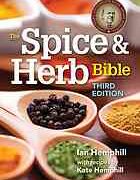The Spice and Herb Bible. Third Edition. With recipes by Kate Hemphill. / Ian Hemphill, 2014. Robert Rose Publishers, Toronto, Canada. 800 pages, color illustrations, tables, bibliography and index.

An appropriately titled book, a collection of 97 herbs and spices thoroughly described with both factual and anecdotal information, The Spice and Herb Bible is a must-have reference for both cooks and foodies. A nearly boundless variety of tastes, from favorite to unusual and exotic, can be appreciated with Hemphill’s matching recipes that number at least two per spice or herb.
At 800 pages, this “bible” is a proper tome. Entries are arranged alphabetically by common name (the English name), followed by a list of names it goes by in many languages, from Arabic to Vietnamese. Names in languages other than English provide a window into the history of trading spices, and might be handy to know if you are planning to make a visit to a foreign land.
Since the Dutch were historically (1600s–1700s) the European spice traders in the South Pacific, their names for many spices and herbs are really close to the commonly accepted English names. Take Parsley, say, and compare with the Dutch “peterslie”, or Cardamom to the Dutch “kardamon”, or Ginger to the Dutch “gember”.
Besides each entry’s text which describes use, processing, buying and storing, and history, there are anecdotes and memories personalizing the experience the author shares with readers. Spices or herbs are enhanced by photography that portrays them recognizably as whole spices or herbs—the best way to procure and keep them, long-term. And each spice or herb profile carries a table containing quick references that show “Culinary Use”, meaning where it’s used to flavor vegetables, baked goods, dairy, etc., with a list of other spices it pairs well with, and finally a list of spice blends it is found in, or essential to.
The nearly 100 spices and herbs that Hemphill so easily recalls in minute detail may be a bit overwhelming at first for the reader. As I sampled the pages of my favorite seasonings, I thought it would be fun to deconstruct some of the spice or herb information, relating it to a specific food group, discover what spices and herbs go with fruits, or creamy desserts.
My first ventures with fruits and spices are childhood memories of dried fruits steeped in water and cinnamon. I hadn’t ever had mango much as a child. But Hemphill’s book gave me an idea with “Cardamom Mangoes”, p. 165—even though his version has sugar and butter—I imagined how mangoes would taste when simmered in coconut oil with dates and crushed green Cardamom seeds! It is so easy to make and really yummy—even if you start with frozen mango!
Much of the book’s value is in the recipes themselves; I could see Hemphill publishing a cookbook entitled “Cooking with Spices”, or similar. More to the point, nestled in the descriptions of each spice and herb are nuggets of ideas when it comes to use. I read that dried basil leaves could be brought to life with lemon juice, water, oil and ground Allspice–a liquid that plumps up the flavor of basil which can be sprinkled over vegetables for grilling. I bet it could be slathered on any vegetables before roasting…
As Hemphill notes early in the book, some spices amalgamate (his word) which means they easily combine, mix and mingle with each other (and with food); they season the food with a flavor that is less overpowering than with a single, pungent or hot spice. Partly because of their ground state when finally added during cooking, and partly because their resins and aromas are so concentrated when freshly dried, most spices offer intense flavor and aroma. This contrasts with herbs, which usually require a delicate touch to help them impart strong essence and fragrance, although more subtly than spices.
In the last big section of the book, “The Art of Combining Spices”, Hemphill shares his secrets for creating spice mixtures. So, if you are blending spices, you can build up your spice muscle and be pretty sure of the result using his methods. Following are traditional spice blends in a dictionary-type listing, from “Asian Stir-fry Seasoning” to “Za’atar”, a full 90 pages worth, with occasional recipes facing a select spice blend.
A word of caution is here stated for vegetarian and vegan readers. Due to a preponderance of recipes for meat-based dishes, this book is definitely biased towards enhancing meat. Despite the meat-based slant, I think the book has value for the novice to professional cook who seek to discover more about the well-known or unusual flavorings and seasonings available for their craft. Such a typical view of the use of spices does not preclude vegans and vegetarians from selecting and using any of the spices in this book for their favorite vegetable and plant-based dishes.
Follow


